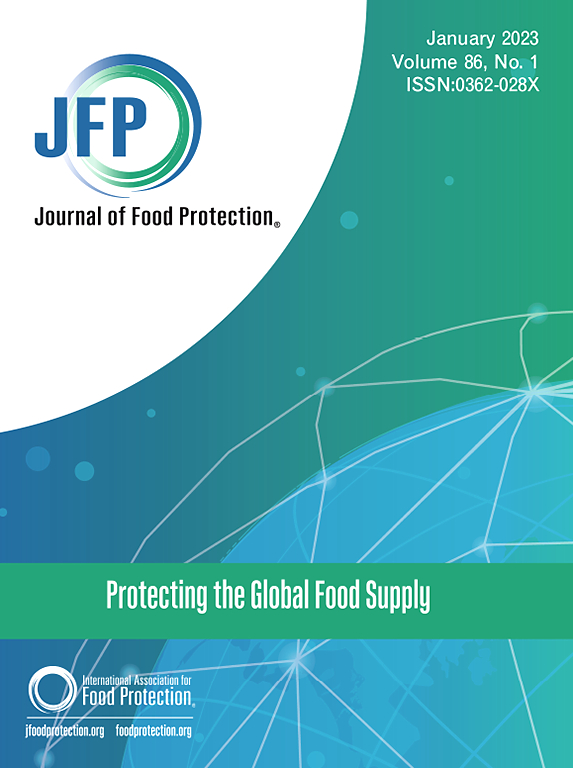Prevalence and Characterization of Campylobacter Species Isolated from U.S. Swine: 2021 NAHMS Enteric Study
IF 2.8
4区 农林科学
Q3 BIOTECHNOLOGY & APPLIED MICROBIOLOGY
引用次数: 0
Abstract
While Campylobacter species are often considered normal gastrointestinal commensal bacteria in many food animals, some species may cause gastrointestinal or reproductive diseases in swine. The U.S. swine industry lacks recent Campylobacter species prevalence estimates, which are useful in animal and public health management recommendations. This study describes the prevalence and characteristics, including antimicrobial resistance (AMR) of Campylobacter species as part of the National Animal Health Monitoring System (NAHMS) Swine 2021 study. Campylobacter species were isolated using culture-based methods, and antimicrobial susceptibility was determined by broth microdilution. Conventional polymerase chain reaction (PCR) was used to detect common AMR genes in isolates resistant to tetracycline, ciprofloxacin, and nalidixic acid. The Enterobacterial Repetitive Intergenic Consensus PCR (ERIC-PCR) was used to assess clonality. A total of 1,043 fecal samples were collected from 39 swine operations. Campylobacter species were detected in 321/1,043 samples (30.8%) and on 32 of 39 operations (82%); two different species were recovered from one sample, yielding 322 isolates. Campylobacter species included C. coli (309/322; 96%) and C. hyointestinalis (13/322; 4%). Six isolates failed to remain viable after storage, yielding 316 for AMR testing. Regardless of species, resistance was most often observed to tetracycline 282/316 (89.2%). Multidrug resistance (MDR to ≥3 drug classes) was observed in 110/316 isolates (51.9%). The tetO gene, determined from isolates prior to storage, was commonly seen (285/322; 88.5%) across all isolates. The ERIC-PCR indicated some clonality by swine operation site but overall lacked the sensitivity to broadly describe the population structure.
从美国猪中分离的弯曲杆菌的流行和特征:2021年NAHMS肠道研究。
在许多食用动物中,弯曲杆菌通常被认为是正常的胃肠道共生细菌,但有些种类可能会引起猪的胃肠道或生殖疾病。美国养猪业缺乏最近的弯曲杆菌种类流行率估计,这对动物和公共卫生管理建议很有用。作为国家动物卫生监测系统(NAHMS)猪2021研究的一部分,本研究描述了弯曲杆菌物种的流行和特征,包括抗菌素耐药性(AMR)。采用培养法分离弯曲杆菌,用微量肉汤稀释法测定其药敏。采用常规聚合酶链反应(PCR)检测对四环素、环丙沙星和萘啶酸耐药的分离株常见AMR基因。使用肠杆菌重复基因间一致性PCR (ERIC-PCR)评估克隆性。从39个养猪场共收集了1,043份粪便样本。1043份标本中检出弯曲杆菌321种(30.8%),39例手术中检出32种(82%);从一个样品中分离出两种不同的菌株,共分离出322株。弯曲杆菌种类包括C. coli (309/322;96%)和hyotestinalis (13/322;4%)。6株菌株在储存后未能保持活力,产生316株用于AMR测试。无论何种菌种,最常见的耐药性是四环素282/316(89.2%)。316株中有110株(51.9%)存在多药耐药(对3种以上药物耐药)。在储藏前从分离株中检测到的tetO基因很常见(285/322;88.5%)。ERIC-PCR显示出一定的猪场克隆性,但总体上缺乏对广泛描述的群体结构的敏感性。
本文章由计算机程序翻译,如有差异,请以英文原文为准。
求助全文
约1分钟内获得全文
求助全文
来源期刊

Journal of food protection
工程技术-生物工程与应用微生物
CiteScore
4.20
自引率
5.00%
发文量
296
审稿时长
2.5 months
期刊介绍:
The Journal of Food Protection® (JFP) is an international, monthly scientific journal in the English language published by the International Association for Food Protection (IAFP). JFP publishes research and review articles on all aspects of food protection and safety. Major emphases of JFP are placed on studies dealing with:
Tracking, detecting (including traditional, molecular, and real-time), inactivating, and controlling food-related hazards, including microorganisms (including antibiotic resistance), microbial (mycotoxins, seafood toxins) and non-microbial toxins (heavy metals, pesticides, veterinary drug residues, migrants from food packaging, and processing contaminants), allergens and pests (insects, rodents) in human food, pet food and animal feed throughout the food chain;
Microbiological food quality and traditional/novel methods to assay microbiological food quality;
Prevention of food-related hazards and food spoilage through food preservatives and thermal/non-thermal processes, including process validation;
Food fermentations and food-related probiotics;
Safe food handling practices during pre-harvest, harvest, post-harvest, distribution and consumption, including food safety education for retailers, foodservice, and consumers;
Risk assessments for food-related hazards;
Economic impact of food-related hazards, foodborne illness, food loss, food spoilage, and adulterated foods;
Food fraud, food authentication, food defense, and foodborne disease outbreak investigations.
 求助内容:
求助内容: 应助结果提醒方式:
应助结果提醒方式:


